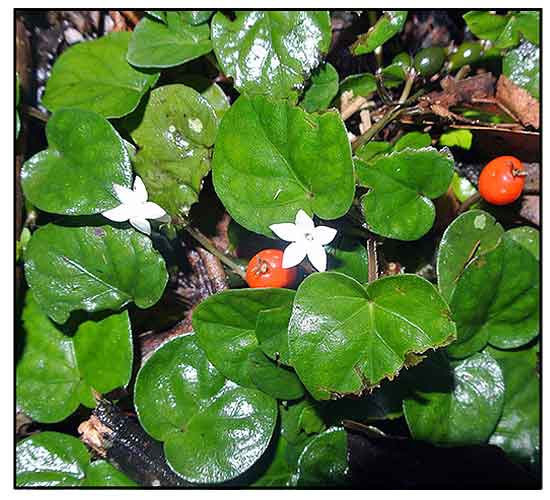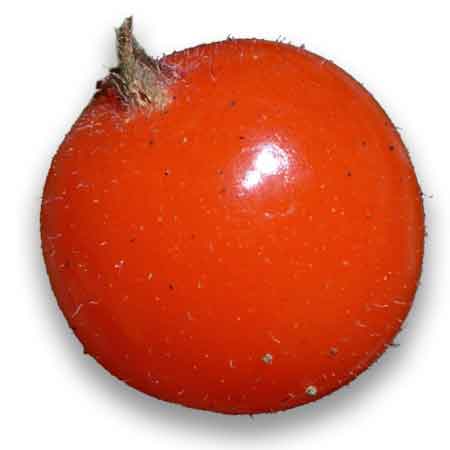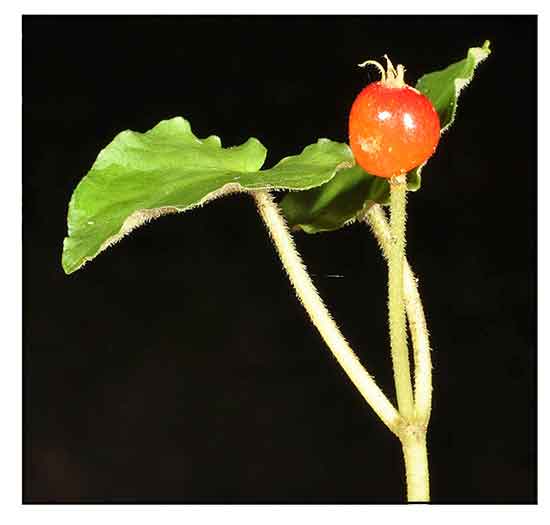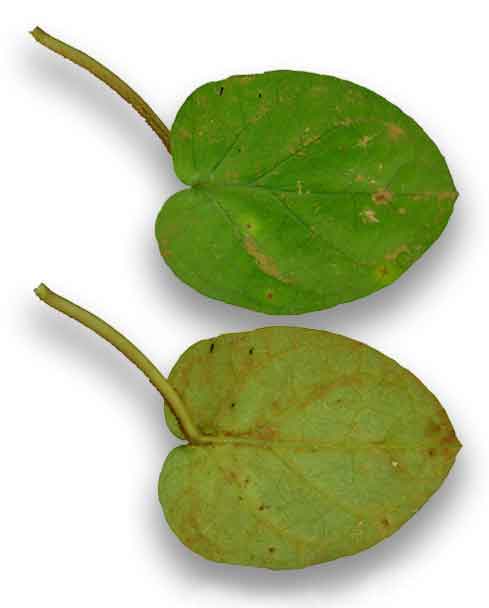 Gen info Gen info
- Geophila is a genus of herbs in the family Rubiaceae. It is a pantropical genus, found in most tropical regions. The name Geophila was once applied to a genus of mushrooms by Lucien Quelet in 1886, with Stropharia inuncta as type species. The usage is not obsolete and illegitimate.
(14)
- Etymology: The genus name Geophila derives from Greek ge, meaning 'earth', and phileo, meaning 'to love', alluding to the creeping habit of the plant, staying close to the ground. (3)
Specific epithet repens derives from Latin repo, meaning "to creep, crawl" referring to the sprawling growth habit.
Botany
• Prostrate herbs; stem slender, stolon-like. Leaves 1.5-2.5 x 1-2 cm, orbicular or broadly ovate to reniform, apex rounded or retuse, chartaceous, basally 5-7-nerved; petiole to 5 cm long. Flowers solitary or in few-flowered umbels; peduncles to 4 cm long. Calyx tube short; lobes subulate, 3 mm long, persistent. Corolla 1-1.5 cm across, funnel-shaped, hairy within, white; lobes recurved, ovate-acute. Stamens 5, included. Ovary 2-locular; ovule 1-per locule. Berry c. 7 mm across, globose, scarlet. Seeds plano-convex. (India Biodiversity Portal)
 • Prostrate creeping herb, rooting at the nodes. Stems 20-30 cm long, densely appressed hairy; flowering shoots, ascending up to c. 7.5 cm high. Leaves up to c. 3.5 × 5.5 cm, kidney-shaped with a broadly rounded apex, hairless above, hairless or pubescent beneath; petiole up to 11.5 cm long. Flowers usually solitary, rarely 2 together, white. Fruit a berry, 5-12 mm in diameter, glossy orange-red when ripe, crowned with the remains of the calyx lobes. (MalawiFlora) • Prostrate creeping herb, rooting at the nodes. Stems 20-30 cm long, densely appressed hairy; flowering shoots, ascending up to c. 7.5 cm high. Leaves up to c. 3.5 × 5.5 cm, kidney-shaped with a broadly rounded apex, hairless above, hairless or pubescent beneath; petiole up to 11.5 cm long. Flowers usually solitary, rarely 2 together, white. Fruit a berry, 5-12 mm in diameter, glossy orange-red when ripe, crowned with the remains of the calyx lobes. (MalawiFlora)
Distribution
- Native to the
Philippines. (2)
- BALABAC, BASILAN, BATAN, BILIRAN, LEYTE, LUZON: Bataan, Camarines Sur, Laguna, Quezon, Sorsogon, MINDANAO: Agusan del Norte, Bukidnon, Davao Oriental, Davao del Sur, Lanao del Norte, Misamis Oriental, Surigao del Sur (photos), MINDORO, NEGROS (photos), PALAWAN, SAMAR.
(2)
- Pantropic.
 Constituents Constituents
- GC and GC-MS studies of Geophila repens for essential oil (GrEO) identified 77 components, which represent 98.0% of the oil. Major components were β-caryophyllene (23.3%), β-elemene (8.0%), farnesyl butanoate (7.4%), myrcene (3.5%), and trans-nerolidol (3.3%). (see study below) (4)
- Study isolated 8 endophytic fungi including Xylaria feejeensis. Large scale culturing, extraction, and purification of the most active fungal extract from X. feejeensis led to isolation of 6′,7′-didehydrointegric acid (1), 13-carboxyintegric acid (2), and four known compounds including integric acid (3). (see study below) (6)
Properties
- Studies have suggested antibacterial, anti-inflammatory, cytotoxicity, antimicrobial, antioxidant, anticholinesterase, learning and memory enhancing, anti-Alzheimer properties.
Parts used
Leaves, roots, aerial parts, essential oil.
 Uses Uses
Edibility
- Seeds reportedly edible.
Folkloric
- No reported folkloric medicinal use in the Philippines.
- In India, leaf infusion used for sore feet. Leaves cooked with food for diarrhea in children. Juice of crushed fruits dripped into eyes for eye infections. (3) Local folk of Andhra Pradesh use hot decoction of leaves for memory enhancement. (13) In Kerala, ground leaves in hot water or milk drunk early morning on an empty stomach for treatment of jaundice. (17)
- Leaves
chewed as remedy for cough. (5)
- Root of plant used for same purpose as ipecac (Caphaelis ipecacuanha), i.e. as an emetic, diaphoretic, and in amoebic dysentery (Chopra et al, 1956).
(7)
- In the Guianas (Guyana, Surinam, French Guiana) plants used as antifungal. In Surinam Tirio, whole plant decoction drunk for treatment of cough. Fruits crushed and rubbed on facial dermatitis consisting of white spots.
- In Malaysia, plant used externally for poulticing sore legs; internally to treat diarrhea. In Thailand, decoction of whole plant used as diuretic and febrifugal. In Africa, leaves eaten as vegetable by barren women suffering fro abdominal troubles and anemia, and used by convalescents to restore vigor and fecundity; also used as baths for infants with fever and to treat inflamed eyes.
In Paraguay, used for treatment of skin diseases. (16)
Others
- Agroforestry: Used as ground cover plant. Forms dense, close colonies in shady areas. (5)
Studies
• Antibacterial / Synergism with Antibiotics / Essential Oil: GC and GC-MS studies of Geophila repens for essential oil (GrEO) identified 77 components, which represent 98.0% of the oil. Study evaluated the antibacterial activities of GrEO and the synergistic effects of
GrEO combined with commercial antibiotics. Results showed GrEO possessed excellent broad spectrum antibacterial activity against Pseudomonas aeruginosa and Bacillus subtilis, and showed synergistic effects in combination with antibiotics. The most prominent synergistic effect was GrEO in combination with Streptomycin against E. coli (fractional inhibitory concentration indices (FICI) of 0.13). The GrEO also exhibited potent inhibitory effect on NO production in LPS-activated RAW 264.7 (murine macrophage) cells. Results suggest potential for the combination of GrEO and commercial antibiotics for development of novel antimicrobial and reduction of drug resistance. (see constituents above) (4)
• Antibacterial Eremophilane Sesquiterpenoids from Endophytic Fungi: Geophila repens is a traditional medicinal plant in Sri Lanka used for treatment of bacterial infection. The antibacterial effects have been attributed to endophytically-produced specialized metabolites. Study isolated 8 endophytic fungi including Xylaria feejeensis. Large scale culturing, extraction, and purification of the most active fungal extract led to isolation of 6′,7′-didehydrointegric acid (1), 13-carboxyintegric acid (2), and four known compounds including integric acid (3). Compounnd 3, integric acid, the key antibacterial component, showed MICs of 16µg/mL against Bacillus subtilis and 64µg/mL against MRSA (methicillin-resistant S. aureus). Results suggest the endophytic fungi should be evaluated as potential source of antibiotics. (6)
• Cyclotides / Antimicrobial / Cytotoxicity: Cyclotides are an intriguing class of structurally stable circular miniproteins of plant origin with numerous potential phamaceutical and agricultural applications. In a study of 50 medicinal plants in Sri Lanka to investigate the occurrence of cyclotides, Geophila repens yielded a suite of new cyclotides. Cycloviolacin 02-like (cy02-like) gere 1 and the known cyclotide kalata B7 (kB7) were characterized as likely involved in cyclotide biosynthesis. Five of the most abundant cyclotides were isolated, sequenced, characterized, and screened in antimicrobial and cytotoxicity assays. All gere cyclotides showed cytotoxicity with IC50s 2.0-10.2 µM, but only gere 1 inhibited standard microbial strains at MICs of 4-16 µM. The cytotoxicity and membrane permeabilizing activities implicates gere cyclotides as potential defense molecules. The presence of cy02-like gere 1 in a Rubiaceae plant supports the notion that phylogenetically distant plants may have coevolved to express similar cytotoxic cyclotides for a specific functional role, most likely for involving host defense. (9)
• Antioxidant / Antifungal / Leaves: Study evaluated the antifungal and antioxidant potential of leaf extract of Geophila repens. The leaf extract scavenged DPPH radicals dose dependently with IC50 of 51.39 µg/ml. An increase in absorbance on increasing concentration of leaf extract indicated ferric reducing activity. The extract showed antifungal activity against Aspergillus niger and Bipolaris sp. with >50% inhibition. (10)
• Anticholinesterase Activity / Antioxidant / Leaves: Study evaluated G. repens extracts of leaves and fractions for antioxidant and anticholinesterase activity using rapid bioautographic enzyme assay for screening AChe and BChe inhibition. Of all extract fractions, the ethyl acetate fraction (EGR) exhibited highest IC50s in DPPH, SOD< NO, OH, and TAC assays with IC50s of 38.33, 45.14, 59.81, 39.45 and 43.76 µg/mL respectively. The EGR displayed competitive reversible inhibition of AChE and BChE activities with IC50s of 68.63 and 59.45 µg/mL respectively. Total phenolic and flavonoid contents of EGR were 360.42 mg GAE and 257.31 mg QE per gram extract. Study attributes the antioxidant and anticholinesterase activities of G. repens to the phenol and flavonoid contents. (11)
• Pentylcurcumene / Cholinesterase Inhibitor for Alzheimer's Disease:
Aerial parts of G. repens has been used in India to improve intelligence and memory. Study iisolated, identified, and quantified a new class of cholinesterase inhibitor from G. repens for Alzheimer's disease. A terpene isolated from hydro-
alcoholic extract was identified as "Pentylcurcumene".
By DPPH, ORAC, and CAP-e assays Pentyl-curcumene showed remarkable degrees of antioxidant activity in a dose-dependent manner and demonstrated anticholinesterase activities with IC50s of73.12 and 97.65 µg/mL for AChE abd BChE, respectively. Results of antioxidant study and molecular docking analysis suggest potential for a first-line cholinesterase-inhibitory for AD. (12)
• Modulatory Role in Mitigating Scopolamine-Induced Neurotoxicity / Leaves: In India, hot leaf decoction is used orally for memory enhancing by the local folk of Andhra Pradesh. Study evaluated the modulatory effects of compounds from leaf extract in modulating scopolamine-induced neurotoxicity in experimental rats of Alzheimer's disease via attenuation of cholinesterase, ß-secretase, MAPt levels, and inhibition of oxidative stress. The GRHA 400 significantly improved learning and memory impairment with improvement of oxidative stress (MDA, SOD, GSH, CAT), DNA damage (8-OHdG), neurochemical (AChE, BuChE, BACE1, BACE2, MAPt) neuroinflammation (IL-6, TNFα) markers in neurotoxic rats. Synergistic action of genistin, quercetin-3-D-galactoside, 9,12,15-octadecatrienoic-acid methyl-ester, phytol, retinal, stigmasterol, n-hexadecanoic acid, β-sitosterol in GRHA restores memory-deficits via attenuation of cholinesterase, β-secretase, MAPt level and inhibition of oxidative-stress imparts inflammation in AD. (13)
• G. repens Phytosome-Loaded Intranasal Gel for Treatment of Alzheimer's Disease: Permeation of phytoconstituents through the blood-brain-barrier is a challenging factor in the development of phyto-
formulation for the treatment of Alzheimer's disease (AD). Study evaluated the effect of Gr phytosome-loaded intranasal gel (MEGR-PG) with enhanced permeation properties through the nasal route to the brain. Transcutol was used as permeation enhancer and hydroxypropyl methylcellulose as gelling agent.
The MEGR-PG exhibited significant in vitro nasal mucosa permeation without causing skin irritation. MEGR-PG exhibited similar proportion of acetylcholinesterase inhibition (97.87%) compared to donepezil (97.17%). greater than MEGR (69.86%), and also accelerated angiogenesis, which showed potential to modify cognitive behavior of AD patients. Study suggest MEGR-PG is a promising treatment option for AD patients. (14)
Availability
- Wild-crafted.
|

![]()







